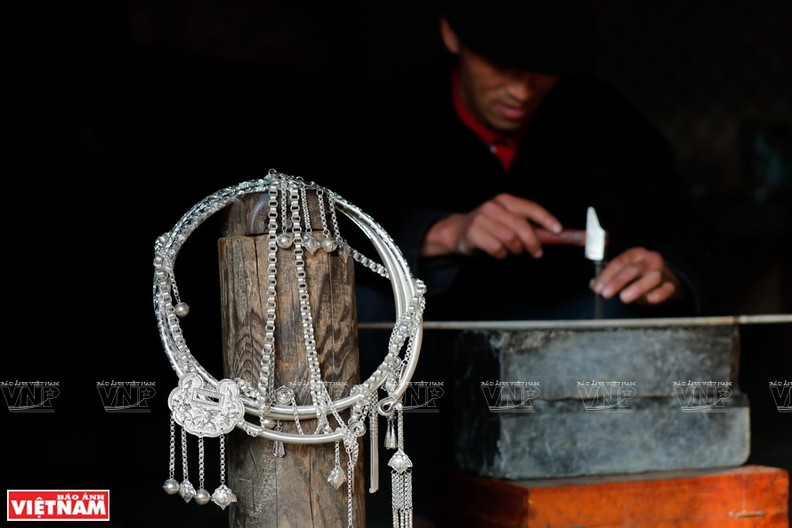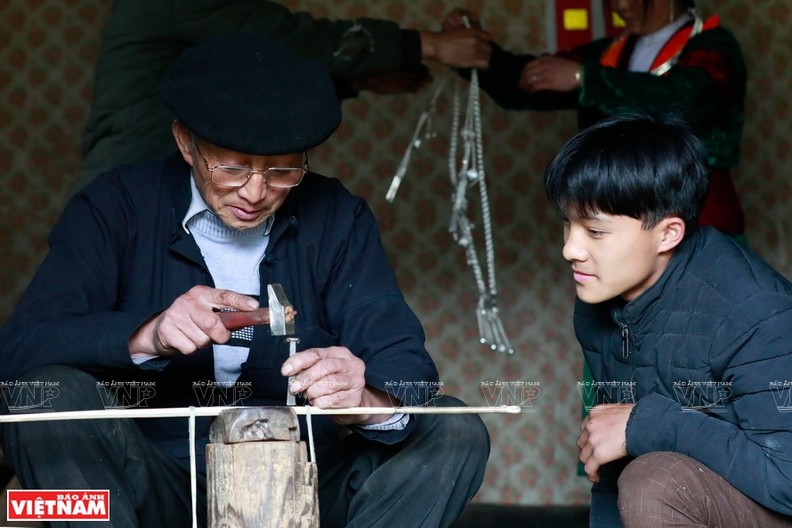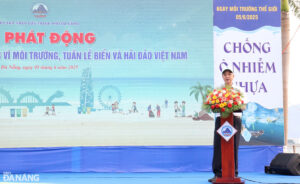On the tourist map, Lao Xa Village in Sung La Commune, Dong Van District, Ha Giang Province, is marked as the “land of early peach blossoms.” Nestled in the Sung La Valley, this small village is surrounded by high mountains, exuding a wild and tranquil beauty.

A corner of Lao Xa Village (Photo: baohagiang.vn)
Lao Xa has a slow and rustic pace of life. The village is home to about 100 households, primarily from the Mong ethnic group, who earn their living through agriculture.
The locals have preserved many ancient ‘trinh tuong’ (earthen) houses with traditional three-room architecture featuring yin-yang tiles and surrounded by grey stone fences. In the courtyards and gardens, there are many peach and plum trees.
This poetic scenery is a typical feature of the Mong people's life in the mountainous region.
When ancient earthen houses turn into homestays
According to Vang Mi Hong, the owner of an ancient earthen house in Lao Xa and the first homestay business in the village, his nearly-a-century-old house has been home to three generations of his family. Now, it has been transformed into a homestay facility to welcome guests.
Hong’s homestay also offers meal services, which treat tourists with local dishes such as indigenous vegetables, smoked pork, grilled fish, and ‘men men’ (a type of corn porridge).
After dinner, Vang Mi Hong introduced tourists to ‘khen’, a traditional musical instrument of the Mong ethnic group, and delivered several panpipe performances.
The Mong people believe that women must know how to weave and embroider, while men must learn to play the flute and panpipe. From a young age, Mong boys are taught to play these instruments by their elders.
In addition to Hong’s houses, several ancient houses in Lao Xa Village have been turned into homestays. The houses’ owners retain the traditional architectural features and arrange them into specific areas to provide guests with comfortable lodging.
The villagers establish a team of local guide teams, offering motorbike taxis, cultural performances and culinary experiences to better serve visitors.
Aware of the importance of keeping their village clean and protecting the environment, they have formed cleaning teams to maintain pathways within the village and plant trees and flowers.
Preserving the traditional craft of silver carving

The delicate Mong necklaces are made by Lao Xa craftsmen. (Photo: Vietnam Pictorial)
Not far from Vang Mi Hong's house are families from the Mua clan, famous for the traditional craft of silver carving. Workers in these small workshops are usually siblings or relatives within families, passing down skills from one generation to another.
The silver carving craft has been practised in Lao Xa for nearly a century. Their products include jewellery such as rings, earrings, necklaces, and bracelets.
Visitors to Lao Xa can easily spot Mong women dressed in traditional attire adorned with silver jewellery of various shapes and designs.
Today, silver crafting has incorporated some machinery. However, more than half of the process remains handcrafted with intricate designs that are symmetrical and captivating.
The silver products from the Mua clan often receive numerous orders from customers across Northwest Vietnam, mainly for making jewellery or gifts for weddings among ethnic groups. According to Mong customs, silver jewellery is also worn during festivals or given to daughters as dowries when they marry.
Among the Mua clan, the most recognised artisan is 73-year-old Mua Se Sinh, born into a family with silver carving passed down through seven generations.
Sinh shared that silver jewellery is an important part of the cultural and spiritual life of Mong people in the mountainous area, as they believe that silver is a holy material which can spell away misfortune and serve as a connection to ancestors and descendants.
The ancient house of Mua Se Sinh has now become a production workshop and display space welcoming visitors for shopping. His workshop has received an increasing number of orders.
Mua Se Sinh has practised the craft since he was a teenager. For many years now, he has dedicated himself passionately to teaching this craft to his grandchildren.
After several years of diligent learning, Mua Tieu Bao, Sinh's 24-year-old grandson, has now become a skilled craftsman. He noted with pride that while most families in the village primarily engage in farming, his Mua clan also earn a living from silver crafting.
In the past, their products were mainly for household use or sold locally. Now, this craft truly provides stable income, he revealed.

Mua Se Sinh has been carving silver for more than half a century. (Photo: Vietnam Pictorial)
The silver crafting tools include bellows, furnaces for melting metal, pots for melting silver, moulds for casting, hammers for shaping, iron pliers, various rolling tools, and engraving chisels.
Silver is melted at high temperatures using a torch before being poured into moulds or rolled thinly before engraving patterns. Finally comes polishing and finishing touches on the products.
Silver carving is meticulous work requiring an understanding of material properties since each handmade product undergoes multiple intricate processing steps. Nowadays, thanks to modern equipment and machinery support, that reduces time and labour while ensuring quality.
Strolling along Lao Xa, visitors can see children playing barefoot together or houses emitting smoke from kitchens while Mong flutes resonate gently with mountain breezes or artisans diligently crafting silver pieces in their workshops. The tranquil and captivating atmosphere has left foreign visitors yearning to return to the small village.
Mai Lu - Translated by NDO
















